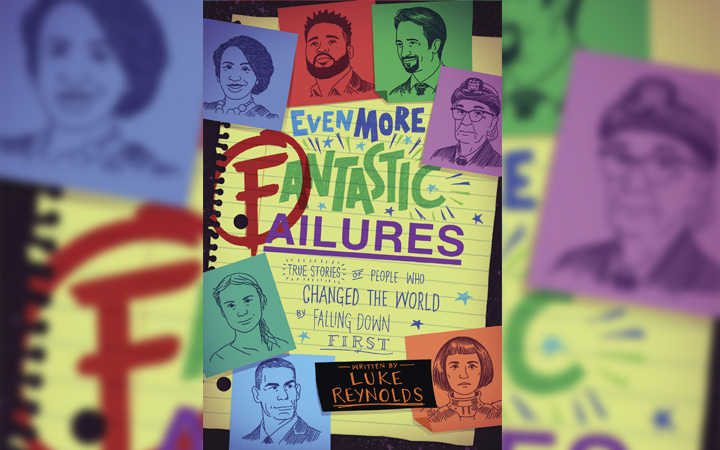“Even More Fantastic Failures”

Jeremy Stoppelman is the cofounder of the far-reaching internet site Yelp. The journey to get there was far from clear, easy, or without some serious flopping along the way.
In 1999, after he’d graduated from college, Stoppelman got his first job working for a home internet provider, @ Home Networks. Instead of an enthralling process of creativity and connection, the job was a flop. He said that the team was “dysfunctional” and couldn’t get anything done. For a few weeks, Stoppelman tried hard to work and figure out a path forward, but then, he said, “I just found myself without a whole lot to do after a few weeks.
I’d kind of run through all the projects that they had for me, and I didn’t really know how to allocate my time.”1 Instead of starting with a burst of success and glamour, Stoppelman’s career in the dot-com industry was starting with a whimper. He didn’t even know what to do when he went to work all day, and the project he was slated to work on with his team was ultimately sidelined as a nonstarter.
So, Stoppelman quit in an attempt to find something more interesting and more viable. He landed at a company called X.com, which would be the forerunner to a site you may know: PayPal.
At the time, Elon Musk (yes, that Elon Musk of Tesla fame!) headed the company and provided a drastic and welcomed change from Stoppleman’s
previous employer. Instead of long hours with seemingly little resolve or mission, Musk filled Stoppelman’s head with wild claims and predictions, such as one idea that X.com would eventually replace all credit card companies, such as Visa and MasterCard. While Stoppelman felt like these notions were outlandish, he said they also provided a genuine and prodigious burst of creativity. They opened the door to entrepreneurship as a process of invention and possibility, of trying and failing, and of attempting to do things that might, at first, seem laughable. Stoppelman never forgot this lesson.
This notion and the encouraging experience eventually helped him and his
partner, Russell Simmons, to take a big risk and start their own company. Their original idea was to create a site where users could log on and ask one another questions. The premise was based on Stoppelman’s sense that the classic Yellow Pages hadn’t undergone any updating in the now-booming internet age. Stoppelman and Simmons hoped that their new idea,
Yelp, would solve that problem and provide a way for people to ask one another for recommendations of where to go for various services and needs.2
The idea was sound and exciting. So, Stoppelman and Simmons hired a team to help them put it into practice. Stoppelman said, “From the moment we got [the idea] we were extremely passionate, started building it, sinking 90-hour weeks into coding and designing the thing… We felt like we were super geniuses.”3
On October 4, the site officially launched, and the buzz party began! Or not. Instead of massive interest and word-of-mouth excitement, the site fizzled. Some people did check it out, but they didn’t stay too long, and they didn’t spread the word about what Stoppelman had hoped would be the biggest and best new website to be unveiled.
Relatively quickly, Stoppelman went from feeling like a super genius to a super failure. He shared, “The consumer reaction? Total flop… From the moment that we launched and started seeing the site not working as expected, it was huge let down. And in fact, it was a real struggle to keep the team together.”4
At this point, Stoppelman and Simmons could have closed their Yelp office and moved on to another project. Except there was a small and intriguing result from the site launch that they almost missed. A few days before the official launch, Simmons had asked Stoppelman if they should embed some kind of review feature into the site—a place where people could write a brief comment about a business, give it some stars and a bit of info—in addition to the main question-and-answer style of the site. Stoppelman had deemed the idea a nonstarter. He didn’t think people would be all that interested in simply writing their own reviews. However, he told Simmons
to go ahead and stick the review function somewhere in the site, as a last-minute add-on, just in case someone felt like doing one.5
This last-minute add-on ended up—as we now know—being the smash hit of the site. Stoppelman and Simmons noticed people posting up to fifteen reviews in that tiny, buried section. They seemed to love it, and they spent most of their time on the site in the review section.
So, instead of shutting down Yelp, they took this small but hopeful sign, temporarily put the site on hold, and completely redesigned it. Then, in the
site’s rerelease, people flocked to it. They wrote reviews, read reviews, and kept coming back again and again and again.
What had quickly smoked out and turned to ashes was now completely rebuilt on the premise of an idea that had previously been seen as a failure.
Though Stoppelman’s path toward Yelp’s success included an aimless job he
quit, and a huge flop when his idea first launched, he stuck with it and eventually co-created a massively powerful and useful website. Sometimes you may feel as though you’re aimlessly wandering, wasting your time.
Other times, you might feel as though your idea or your ability is at the “super genius” level—there’s no way you can fail. Either way, you’re okay. You are where you need to be. As long as you keep attempting, your confusion may be strong sometimes, and at other times, your confidence may soar. What matters is that you keep moving forward. Keep your vision wide to see how what might have been a flop could be a clue to a future success. Then, go back to your notebook, craft a new possibility, and try again.
Citations:
- Victor Luckerson, “Why Yelp’s CEO Turned Down Google,” Time, December 1, 2014, https://time.com/3611053/yelp-ceo/.
- Luckerson, “Why Yelp’s CEO Turned Down Google.”
- Daniel Wolfman and Chris Beier, “Yelp’s Jeremy Stoppelman: ‘What the Hell Am I Doing?’” Inc., December 4, 2012, https://
www.inc.com/chris-beier-and-danielwolfman/jeremy-stoppelman-yelp-launchstrategy.html. - Wolfman and Beier, “Yelp’s Jeremy Stoppelman.”
- Wolfman and Beier, “Yelp’s Jeremy Stoppelman.”

 bout the Author
bout the Author




